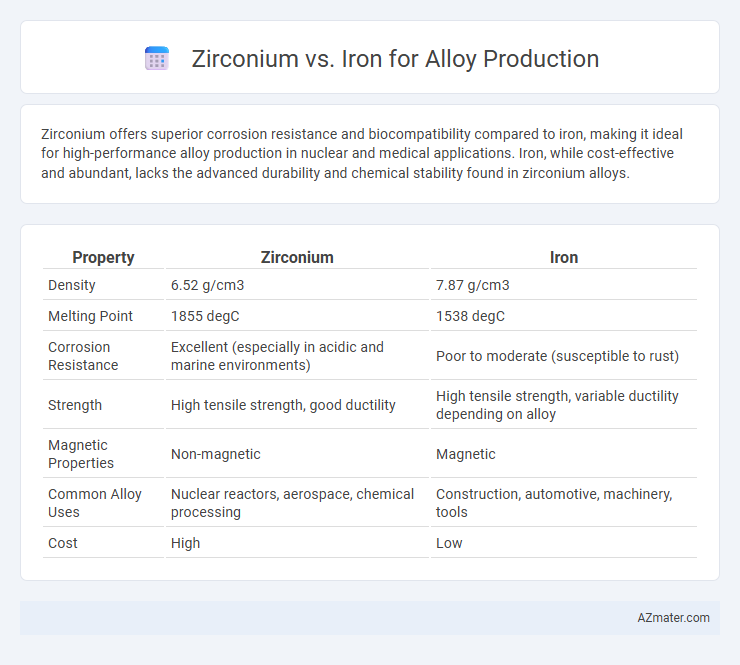Zirconium offers superior corrosion resistance and biocompatibility compared to iron, making it ideal for high-performance alloy production in nuclear and medical applications. Iron, while cost-effective and abundant, lacks the advanced durability and chemical stability found in zirconium alloys.
Table of Comparison
| Property | Zirconium | Iron |
|---|---|---|
| Density | 6.52 g/cm3 | 7.87 g/cm3 |
| Melting Point | 1855 degC | 1538 degC |
| Corrosion Resistance | Excellent (especially in acidic and marine environments) | Poor to moderate (susceptible to rust) |
| Strength | High tensile strength, good ductility | High tensile strength, variable ductility depending on alloy |
| Magnetic Properties | Non-magnetic | Magnetic |
| Common Alloy Uses | Nuclear reactors, aerospace, chemical processing | Construction, automotive, machinery, tools |
| Cost | High | Low |
Introduction to Alloy Production
Zirconium and iron possess distinct properties that significantly influence their use in alloy production, with zirconium valued for its high corrosion resistance and strength at elevated temperatures, making it ideal for aerospace and nuclear applications. Iron, the most abundant metal used in steel alloys, provides excellent tensile strength and versatility, essential for construction and automotive industries. The choice between zirconium and iron alloys depends on the specific performance requirements, such as resistance to oxidation or mechanical durability.
Properties of Zirconium in Alloys
Zirconium exhibits exceptional corrosion resistance, high melting point (about 1855degC), and excellent strength-to-weight ratio, making it a valuable element in alloy production. Its low neutron absorption cross-section enhances performance in nuclear applications, unlike iron which has limited resistance to oxidation and corrosion under extreme conditions. Zirconium alloys maintain structural integrity at elevated temperatures, offering superior durability compared to traditional iron-based alloys.
Properties of Iron in Alloys
Iron exhibits outstanding mechanical strength and excellent ductility, making it a favored base metal in alloy production, particularly in steel manufacturing. Its high tensile strength and good corrosion resistance, when alloyed with elements like carbon, chromium, and nickel, enhance durability and wear resistance for industrial applications. Iron's magnetic properties and thermal conductivity also contribute to its wide utilization in structural components and machinery.
Strength and Durability Comparison
Zirconium alloys demonstrate superior corrosion resistance and maintain high strength at elevated temperatures, making them ideal for nuclear reactor components where durability under extreme conditions is crucial. Iron-based alloys, particularly steels, offer exceptional tensile strength and toughness at lower costs, widely used in construction and automotive industries for their balance of durability and economic efficiency. While iron alloys excel in mechanical strength and affordability, zirconium alloys provide enhanced longevity and stability in highly corrosive or high-temperature environments, emphasizing their specialized application in alloy production.
Corrosion Resistance: Zirconium vs Iron
Zirconium exhibits superior corrosion resistance compared to iron, especially in aggressive environments like acidic and chloride-rich settings used in alloy production. Its ability to form a stable, protective oxide layer prevents degradation and extends the lifespan of alloys in chemical processing and marine applications. Iron alloys, while versatile, are more prone to rust and corrosion unless treated or alloyed with additional elements to improve durability.
Cost and Availability of Zirconium and Iron
Iron remains significantly more cost-effective and widely available than zirconium for alloy production, largely due to its abundant presence in the earth's crust and established global mining infrastructure. Zirconium, though offering superior corrosion resistance and high-temperature strength, commands a higher price because of its complex extraction process from zircon minerals and limited global supply concentrated in a few regions. These factors often make iron the preferred base metal for large-scale alloy manufacturing where cost and availability are critical considerations.
Applications in Industry
Zirconium alloys are highly valued in nuclear reactors and chemical processing industries due to their exceptional corrosion resistance and high melting point, making them ideal for harsh environments. Iron alloys, such as steel, are widely used in construction, automotive, and machinery manufacturing because of their superior strength, versatility, and cost-effectiveness. Industrial applications prioritize zirconium for specialized roles requiring chemical inertness, while iron dominates general-purpose alloy production for structural and mechanical components.
Environmental Impact and Sustainability
Zirconium alloys exhibit lower corrosion rates and longer lifespans compared to iron-based alloys, reducing the frequency of replacements and waste generation in industrial applications. The extraction and processing of zirconium typically involve less greenhouse gas emissions and produce fewer toxic byproducts than iron mining and smelting. Utilizing zirconium in alloy production supports sustainability by enhancing material durability and minimizing environmental degradation throughout the product lifecycle.
Advances in Alloy Manufacturing
Advances in alloy manufacturing have leveraged zirconium's superior corrosion resistance and high strength-to-weight ratio to enhance performance in aerospace and nuclear applications, contrasting with iron's traditional dominance in structural alloys due to its cost-effectiveness and magnetic properties. Modern techniques such as powder metallurgy and additive manufacturing facilitate precise zirconium alloy compositions, optimizing mechanical properties and increasing production efficiency. The integration of zirconium allows for alloys with improved thermal stability and oxidation resistance, vital for extreme environment applications where iron-based alloys often underperform.
Choosing the Right Metal for Alloys
Zirconium offers exceptional corrosion resistance and high-temperature stability, making it ideal for aerospace and nuclear applications where durability under extreme conditions is crucial. Iron, valued for its strength and cost-effectiveness, dominates in construction and automotive industries but lacks the superior corrosion resistance of zirconium. Selecting the right metal for alloy production depends on balancing performance requirements, environmental exposure, and budget constraints to optimize alloy functionality.

Infographic: Zirconium vs Iron for Alloy Production
 azmater.com
azmater.com